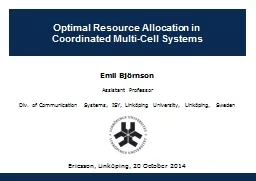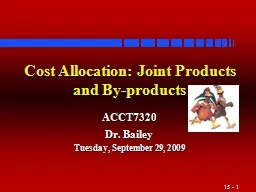PPT-Cost Allocation: Joint Products and By-products
Author : pamella-moone | Published Date : 2015-10-16
ACCT7320 Dr Bailey Nature of Cost Allocations Pervasive in accounting Across time depreciation Between departments eg service depts To products customers branch
Presentation Embed Code
Download Presentation
Download Presentation The PPT/PDF document "Cost Allocation: Joint Products and By-p..." is the property of its rightful owner. Permission is granted to download and print the materials on this website for personal, non-commercial use only, and to display it on your personal computer provided you do not modify the materials and that you retain all copyright notices contained in the materials. By downloading content from our website, you accept the terms of this agreement.
Cost Allocation: Joint Products and By-products: Transcript
Download Rules Of Document
"Cost Allocation: Joint Products and By-products"The content belongs to its owner. You may download and print it for personal use, without modification, and keep all copyright notices. By downloading, you agree to these terms.
Related Documents














